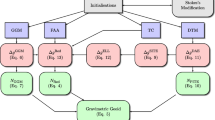Abstract
The aim of this paper is to investigate the effect of implementing the experimentally determined GEMMA Moho depths (GOCE Exploitation for Moho Modeling and Applications), which are partly seismically estimated, in gravimetric geoid computation in Egypt. The window remove-restore technique has been proposed to avoid the double consideration of the topographic-isostatic masses in the neighbourhood of the computational point. The plate loading theory has been used to model the seismically determined Moho depths. A constant density contrast between the lower crust and the upper mantle has been postulated. The tailored geopotential model EGTGM2014 has been used for the long wavelength contributions of the Earth’s gravity field. A comparison with a geoid computed using the EGM2008 and Airy floating hypothesis has been made. For all cases, a gravimetric geoid for Egypt has been computed using Stokes’ integral in the frequency domain by 1-D FFT technique. The computed geoids are fitted to the GPS-levelling derived geoid using an optimum geoid fitting technique for Egypt introduced by the author. The results show that using the seismically determined Moho depths within the plate loading theory and the EGTGM2014 tailored geopotential model gives a geoid with external accuracy of about 16 cm.
Similar content being viewed by others
References
Abd-Elmotaal H., 1991. Gravity Anomalies Based on the Vening Meinesz Isostatic Model and Their Statistical Behaviour. Mitteilungen der geodätischen Institute der Technischen Universtät Graz, 72, Graz, Austria.
Abd-Elmotaal H., 1993. Vening Meinesz Moho depths: traditional, exact and approximated. Manuscripta Geodaetica, 18(4), 171–181.
Abd-Elmotaal H., 2001. Precise geoid computation using seismic Moho information. Boll. Geod. Sci. Affini, 60, 227–238.
Abd-Elmotaal H., 2003. Implementing seismic Moho depths in geoid computation. Surv. Rev., 37, 235–245.
Abd-Elmotaal H., 2014. Egyptian geoid using ultra high-degree tailored geopotential model. Proceedings of the 25th International Federation of Surveyors FIG Congress, Kuala Lumpur, Malaysia, June 16–21, 2014 (http://www.fig.net/pub/fig2014/papers/ts02a/TS02A_abdelmotaal_6856.pdf).
Abd-Elmotaal H., Abd-Elbaky M. and Ashry M., 2013. 30 meters Digital Height Model for Egypt. Presented at VIII Hotine-Marussi Symposium, Rome, Italy, June 17–22, 2013 (https://www.researchgate.net/publication/273143491_30_Meters_Digital_Height_Model_ for_Egypt).
Abd-Elmotaal H. and Kühtreiber N., 1999. Improving the geoid accuracy by adapting the reference field. Phys. Chem. Earth, 24, 53–59, DOI: 10.1016/S1464-1895(98)00010-6.
Abd-Elmotaal H. and Kühtreiber N., 2001. Astrogeodetic geoid determination using seismic Moho information. International Geoid Service Bulletin (IGeS), 11, 80–92.
Abd-Elmotaal H. and Kühtreiber N., 2002. High accurate geoid using adapted reference field and seismic Moho depths. International Geoid Service Bulletin (IGeS), 13, 2–12.
Abd-Elmotaal H. and Kühtreiber N., 2003. Geoid determination using adapted reference field, seismic Moho depths and variable density contrast. J. Geodesy, 77, 77–85.
Abd-Elmotaal H. and Kühtreiber N., 2014a Automated gross error detection technique applied to the gravity database of Africa. Geophys. Res. Abs., 16, EGU2014-92.
Abd-Elmotaal H. and Kühtreiber N., 2014b. The effect of DHM resolution in computing the topographic-isostatic harmonic coefficients within the window technique. Stud. Geophys. Geod., 58, 41–55, DOI: 10.1007/s11200-012-0231-6.
Abd-Elmotaal H. and Kühtreiber N., 2015. On the computation of the ultra-high harmonic coefficients of the topographic-isostatic masses within the data window. Geophys. Res. Abs., 17, EGU2015-355.
Abd-Elmotaal H. and Makhloof A., 2013. Gross-errors detection in the shipborne gravity data set for Africa. Presented at Geodetic Week, Essen, Germany, October 8–10, 2013 (http://www.uni-stuttgart.de/gi/research/Geodaetische_Woche/2013/session02/Abd-Elmotaal-Makhloof.pdf).
Abd-Elmotaal H. and Makhloof A., 2014. Optimum geoid fitting technique for Egypt. Geophys. Res. Abs., 16, EGU2014-1537.
Brotchie J.F. and Silvester R., 1969. On crustal flexure. J. Geophys. Res., 74, 5240–5252.
Haagmans R., de Min E. and van Gelderen M., 1993. Fast evaluation of convolution integrals on the sphere using 1D FFT, and a comparison with existing methods for Stokes’ integral, Manuscripta Geodaetica, 18, 227–241.
Kakkuri J. and Wang Z.T., 1998. Structural effects of the crust on the geoid modelled using deep seismic sounding interpretations. Geophys. J. Int., 135, 495–504.
Majdański M., Kozlovskaya E., Świeczak M. and Grad M., 2008. Interpretation of geoid anomalies in the contact zone between the East European Craton and the Palaeozoic Platform-I. Estimation of effects of density inhomogeneities in the crust on geoid undulations. Geophys. J. Int., 177, 321–333.
Marti U., 2004. High precision combined geoid determination in Switzerland. Proc. IAG GGSM2004 Symp. Porto, Portugal (https://dav0.bgdi.admin.ch/swisstopo/about/publi/pdf /GGSM04_CHGEO_RE.pdf).
Moritz H., 1990. The Figure of the Earth: Theoretical Geodesy and the Earth’s Interior. Wichmann, Karlsruhe, Germany.
Pavlis N.K., Holmes S.A., Kenyon S.C. and Factor J.K., 2012. The development and evaluation of the Earth Gravitational Model 2008 (EGM2008). J. Geophys. Res., 117, B04406, DOI: 10.1029/2011JB008916.
Reguzzoni M. and Sampietro D., 2015. GEMMA: An Earth crustal model based on GOCE satellite data. Int. J. Appl. Earth Obs. Geoinf., 35, 31–43.
Sideris M.G. and Li Y.C., 1993. Gravity field convolutions without windowing and edge-effects. Bull. Geod., 67, 107–118.
Turcotte D.L. and Schubert G., 1982. Geodynamics: Applications of Continuum Physics to Geological Problems. John Wiley & Sons, New York.
Vening Meinesz F.A., 1940. Fundamental Tables for Regional Isostatic Reduction of Gravity Values. Koninklijke Nooerlandsche Akademie van Wetenschappen Amsterdam, Amsterdam, The Netherlands (http://www.dwc.knaw.nl/DL/publications/PU00011463.pdf).
Author information
Authors and Affiliations
Corresponding author
Rights and permissions
About this article
Cite this article
Abd-Elmotaal, H.A. Gravimetric geoid for Egypt implementing Moho depths and optimal geoid fitting approach. Stud Geophys Geod 61, 657–674 (2017). https://doi.org/10.1007/s11200-015-1258-2
Received:
Revised:
Accepted:
Published:
Issue Date:
DOI: https://doi.org/10.1007/s11200-015-1258-2




